Axial Base Primary Node (PN03A)
The Axial Base Primary Node (PN03A) is located near the base of the Axial Seamount at the far western edge of the Juan de Fuca tectonic plate, ~2,600 meters deep.
The Axial Seamount is far from the continental shelf (>350 km) and represents an open-ocean or pelagic site in the continuum of observing scales represented in the OOI’s cabled array. Here, large-scale currents including the North Pacific Current, the subpolar gyre and the northern end of the California Current interact. These currents transport heat, salt, oxygen, and biota, all of which are crucial to the region’s ecosystem. However, their variability arises from forcing as varied as tides and winds to interannual (El Niño) to decadal (Pacific Decadal Oscillation) timescales. This area is also impacted by undersea eruptions in the form of megaplumes, and most likely by internal tides due to the steep walls of the seamount. PN3A provides power and bandwidth to an array of moorings and seafloor instrumentation, as well as to Primary Node PN3B at the summit of Axial Seamount.
As with other Primary Nodes, PN3A rests on the seafloor and is connected to the land-based shore station in Pacific City, Oregon via fiber-optic cables. Primary Nodes convert high power from the shore station to a lower power and distribute that power and communication to junction boxes within the Cabled Array through their science ports. Primary Nodes also receive data and communications from the junction boxes which they transmit back to shore.
This particular Primary Node, PN3A, provides power and bandwidth to all Axial Base Cabled infrastructure, including:

